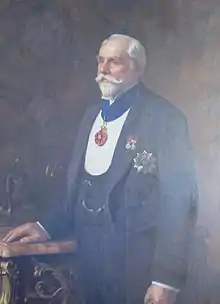Guilford Lindsey Molesworth
Sir Guilford Lindsey Molesworth KCIE (1828–1925) was an English civil engineer.
Sir Guilford Lindsey Molesworth | |
|---|---|
 | |
| Born | 1828 |
| Died | 1925 |
| Nationality | English |
| Occupation | Engineer |
| Engineering career | |
| Discipline | Civil, |
| Institutions | Institution of Civil Engineers (president), |
| Projects | Royal Arsenal, Woolwich |
Biography
Early years
Molesworth was born in Millbrook, Hampshire and was the son of John Edward Nassau Molesworth, Vicar of Rochdale who was a great grandson of Robert Molesworth, 1st Viscount Molesworth.[1] Sir Guildford's great niece was Margaret Patricia Molesworth (1904–1985), the grandmother of Sophie, Duchess of Edinburgh.[2][3] Molesworth was educated at the College for Civil Engineers at Putney, apprenticed under Mr Dockray in the London and North Western Railway, and under Sir William Fairbairn at Manchester.
Career
He became a chief assistant engineer of the London, Brighton and South Coast Railway, but soon resigned to conduct the constructions at the Royal Arsenal, Woolwich, during the Crimean War. He received the Watt Medal and the Manby premium in 1858 from the Institution of Civil Engineers for his paper on Conversion of Wood by Machinery. He returned to London for a number of years, worked at his profession, then went to Ceylon in 1859 and in 1862 became chief engineer of the government railways in Ceylon. From 1871 to 1889 he was consulting engineer to the Indian government with regard to State railways. In May 1888, he was made a Knight Commander of the Order of the Indian Empire (KCIE).[4] He received medals from the British Government for his services during the Afghan War and the Burma War, and was president of the Institution of Civil Engineers in 1904.[5][6]
Gauge
Molesworth was consulted on a number of occasions on the suitability of adopting a narrow gauge rather than a broad one. He was generally against the narrow gauge as he regarded the cost savings as illusory. His broad gauge line to Kandy was meant to prove that the gauge was practicable in steep mountains.
Bibliography
He published the Molesworth's Pocket Book of Engineering Formulae. This useful little volume contained formulas and details on many engineering related subjects. The first edition was published in November 1862 and ran to over thirty editions (The twenty-eighth edition[7] was published in 1921).
His other works include:
- State Railways in India (1872)
- Metrical Tables (1880; fourth edition, 1909)
- Imperialism in India (1885)
- Silver and Gold (1891)
- Our Empire under Protection and Free Trade (1902)
- Economic and Fiscal Facts and Fallacies (1909)
- Indian Railway Policy (1920)
References
- Beeching, H. C. (1894). . In Lee, Sidney (ed.). Dictionary of National Biography. Vol. 38. London: Smith, Elder & Co.
- Burke's Peerage, Baronetage & Knightage, 107th edition, volume 2, 2003. pages 2721–2731.
- "Molesworth History". moleswoth.id.au. Retrieved 6 October 2017.
In 1999, when I (the Right Honourable the (12th) Viscount Robert Molesworth) had the honour to be invited to Windsor Castle to represent the family at the marriage of Prince Edward to Sophie Rhys-Jones (whose paternal grandmother was Margaret Patricia Molesworth)....
- Great Britain. India Office The India List and India Office List for 1905, p. 145, at Google Books
- Watson, Garth (1988), The Civils, London: Thomas Telford Ltd, p. 252, ISBN 0-7277-0392-7
- Anon. (1887). "Guilford L. Molesworth". Indian Engineering: 222.
- Molesworth, Sir Guilford L. (1921). Molesworth's Pocket Bool of Engineering Formulae. E. & F.N. Spon Ltd., 57 Haymarket, London.
External links
- "A GREAT ENGINEER". The Sydney Morning Herald. National Library of Australia. 17 June 1922. p. 8. Retrieved 13 July 2012.